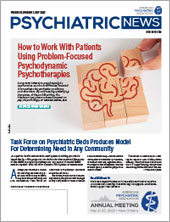An individual has recovered from alcohol use disorder (AUD) when he or she achieves both remission from AUD as defined by DSM-5-TR criteria and cessation of heavy drinking, according to a research definition developed by the National Institute on Alcohol Abuse and Alcoholism (NIAAA).
Brett Hagman, Ph.D., program director for the treatment, health services, and recovery branch of NIAAA, told Psychiatric News that the focus on those two outcomes provides a framework and measurable endpoints for investigators doing clinical research in a field that has been lacking in a clear, objective definition of recovery. The definition was formulated by NIAAA after consultation with other experts in substance use disorders and recovery science and was posted on the NIAAA website last year.
An article about the definition by Hagman and NIAAA colleagues, including NIAAA Director George Koob, Ph.D., was posted April 12 in AJP in Advance.
“There have been many attempts to define recovery, and people come at this with a lot of passion,” Hagman said in an interview. “As a research institute focused on alcohol misuse, we have never had a good framework for defining recovery that our investigators could work with. This will help us standardize what we mean when we talk about recovery.”
He said the two main outcomes can also be of use to psychiatrists and mental health professionals because both can be reliably assessed clinically.
The definition of recovery does not require abstinence, although Hagman said that abstinence is an ideal. According to NIAAA, cessation of heavy drinking is defined as drinking no more than a total of 14 drinks in a week or four drinks on a single day for men and drinking no more than a total of seven drinks in a week or three drinks a day for women. Recovery also requires remission from the symptoms associated with alcohol use listed in the criteria for AUD in DSM-5-TR—with the exception of craving (see box below).
Remission Broken Into Four Periods
Remission from AUD is further qualified in the NIAAA definition by four temporal periods: “initial” (up to three months, a highly unstable period when individuals are at the greatest risk for relapse), “early” (three months to one year, a still tenuous but relatively stable period), “sustained” (one to five years, a period of greater stability), and “stable” (greater than five years, when individuals in recovery are more likely to remain in remission).
A third principal component of the NIAAA definition is biopsychosocial functioning and quality of life, defined as “fulfillment of basic needs; enhancements in social supports and spirituality; and improvements in physical and mental health, quality of life, and other dimensions of well-being.”
Hagman acknowledged that the latter outcomes need to be better defined and said he hopes that further research will help to develop measurable endpoints to describe biopsychosocial wellness.
The AJP article noted that nearly the entire recovery community agrees that some aspect of biopsychosocial wellness is critical to recovery. According to the article, “[T]he Recovery Science Research Collaborative, an interdisciplinary collaboration of recovery researchers and other stakeholders, operationally defined recovery as ‘an individualized, intentional, dynamic, and relational process involving sustained efforts to improve wellness.’ ”
The Substance Abuse and Mental Health Services Administration also developed a definition of recovery from substance use disorder, defined as “a process of change through which individuals improve their health and wellness, live a self-directed life, and strive to reach their full potential.’’
The AJP article noted that the Betty Ford Institute convened a consensus panel in 2007 comprising various recovery stakeholders and defined recovery as “a voluntarily maintained lifestyle characterized by sobriety, personal health, and citizenship.”
NIAAA Definition Is ‘Abstinence Friendly’
Smita Das, M.D., chair of the APA Council on Addiction Psychiatry, said the NIAAA recovery definition is an important contribution in an evolving field of research on AUD and recovery.
She pointed out that recovery has different meanings in different settings. “Here, we are discussing an endpoint for the purpose of having a measurable research outcome. In the community, ‘recovery’ is often a process or a journey.”
She said the focus on measurable outcomes is compatible with how practitioners work with patients with AUD. “We often discuss goals with our patients, and we identify how alcohol has impacted their lives. Having a standard goal is helpful to benchmark against. This definition aligns with diagnostic criteria and is easy to follow.”
Potentially controversial—at least from the standpoint of public perception—is how the NIAAA definition appears to run counter to the insistence on abstinence commonly associated with 12-step recovery programs.
Hagman said there is a sizable body of research dating back decades demonstrating that some individuals are able to achieve control over their drinking without abstinence. But he acknowledged that abstinence from alcohol is almost always recommended for patients with AUD—at least for a period—and that for many patients abstinence may always be necessary.
“Our definition is abstinence friendly,” he said.
“It is important to meet patients where they are at, to keep the door open to options,” said Das. “For many, abstinence may be the most reasonable way to go, but if harm reduction can help them engage in treatment, that is a win. Truly patient-centered care takes into account patients’ needs and desires. For me, a patient showing up to an appointment, even if the patient doesn’t have clear goals in mind to start, is a path forward.”
Hagman emphasized that the recovery definition is expected to be refined over time. In the AJP article, he and colleagues wrote: “Research is encouraged to better understand how aspects of well-being and biopsychosocial functioning, remission from AUD, and cessation of heavy drinking affect recovery. For example, research is needed to identify which are the most reliable and valid measures of well-being, quality of life, and biopsychosocial functioning that accurately predict successful drinking and recovery outcomes.” ■
